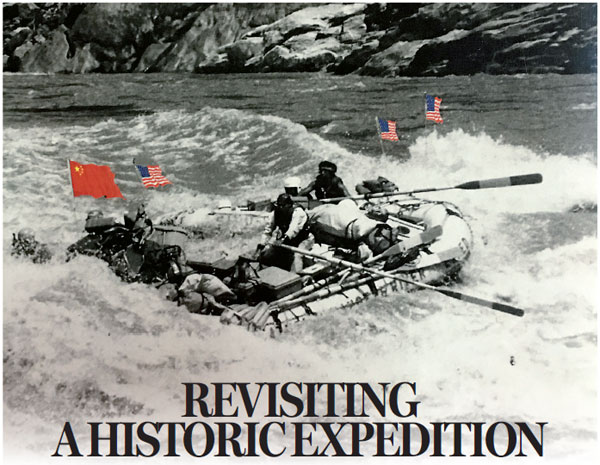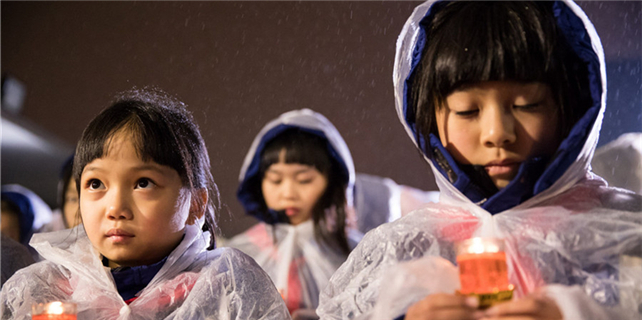Revisiting a historic expedition
Members of the Sino-US rafting team reunite in China and recall of the famous 1986 adventure

It has been 30 years since the Sino-US Upper Yangtze River expedition, but when members of the two sides met in Beijing again at the end of October, everyone broke down in tears as they hugged.
"During the party in Beijing, all of us drank late into the night as we laughed and sobbed," said Chu Siming, a key member of the bilateral rafting excursion in 1986.
The event was the only joint river rafting expedition to be approved by the highest authority in China. Several Chinese teams, all of which had little experience in rafting, joined in the action in an attempt to prevent a foreigner from being the first person to raft the Yangtze river, the longest river in China. A total of 11 people, including one American, lost their lives.
Three decades later, no one has accomplished or even attempted to raft down the same route of the Yangtze River again.
"The 1986 rafting expedition is such a bad memory and may have terrified the young people," said Chu, who had many years ago given up on the sport. He is now into real estate investment and the art business.
Big ambitions
The 1986 rafting expedition was such a momentous affair that it hit the headlines in both China and the United States. Most Chinese media followed the two local teams which were competing against the joint team.

As no Chinese person had ever successfully rafted the Yangtze River, many people were unhappy with the fact that the country's sports authority had given foreigners the right to do so. The China Sports Service Company signed a contract with Ken Warren, allowing him to raft on the upper level of the Yangtze River and develop commercial rafting later on, for $800,000.
"In the 1980s, China had just opened its economy to the outside world and many government departments were seeking projects to earn profits," said Chu, who was an employee at the China Sports Service Company, affiliated to the sports authority.
In response to the criticisms, the company decided to select some Chinese rafters to join the US team. However, no one was willing to do so because everyone thought the sport was too dangerous.
"But I signed up anyway. I was young and willing to do anything new and exciting," said Chu, a former hockey player. The sports company also managed to find another two members to join the joint team.
By then, the news of the joint expedition had already garnered much interest in both countries. In China, many young people were preparing to go on their own expeditions, the most notable of whom was Yao Maoshu, a rafting enthusiast from Sichuan province. It was reported that the 32-year-old had told his wife to get an abortion before he embarked on the expedition, fearing that she would become a widow burdened with a child should he not return.
Yao started his voyage in June 1985 and is believed to have drowned in the Jinshajiang section of the Yangtze River after rafting for nearly 1,300 kilometers. He was later deemed a national hero.
Seemingly motivated by Yao's actions, many young Chinese men joined the competition to raft the Yangtze River the following year. Like Yao, nine Chinese rafters were killed at the same Jinshajiang stretch of the river.
"We admire all these rafters, always, as they are dreamers. There is nothing wrong with dreams," said Jan Warren during her recent trip to Shanghai and Beijing.
An unfathomable power
According to the plan, the eight-week journey would cover over 3,000 kilometers of virtually uncharted waters. All the rafters knew was that they had to navigate through dozens of waterfalls and drops totaling over 5,000 meters.
Till today, Chu can still vividly recall the power the river and he claims that some sections of the Yangtze may never be conquered due to the force of the rapids. He pointed out that Tiger Leaping Gorge, or Hu Tiao Xia, located in northwestern Yunnan, is one such section.
When the team was about 320 kilometers from Tiger Leaping Gorge, the late joint team leader Ken Warren wrote in his diary on Aug 28: "We were mauled by the river, bounced around like on the inside of a pinball machine or maybe a washing machine...In a dream-like sequence, our boat was crushed by a mountain of water. It felt like we had hit a brick wall at 20 miles an hour."
"There were rocks hidden under the rapids and turbulence behind the rock, the river was unexpected, you would find the buoyancy principle is not applicable anymore, the power of rapids pulled you into the hole. Sometimes, you were like a vehicle rushing down without brakes. I can't express my fear in words," Chu told China Daily USA.
Fearing their lives, four US members quit the expedition and hiked through the wilderness to look for help. After losing contact with the outside world for more than 10 days, Ken Warren hiked out of the no-man zone and declared the end of the expedition.
Revisiting the past
During summer this year, a long story about the 1986 expedition was widely circulated on China's major social networks. Two young reporters Du Xiuqi and Chen Chuhan spent four months interviewing members of the Chinese teams and revisited the 3,000-km route from Xining of Qinghai province to Batang near Chengdu of Sichuan province, where Ken Warren's team ended the adventure.
"I happened to chance upon the memorial of the expedition in Tiger Leaping Gorge when I traveled there earlier this year. I found this to be a shocking and touching tale but realized that young people like me knew nothing about it before," said Chen, who was born in the 1990s.
Chu said that instead of comparing the expedition to an adventure gone wrong, people should see it as a test of human resolve.
"I found rafting to be more about what it means to be human than an adventure. In an extremely dangerous and unfamiliar situation, even a little problem can be amplified into a big one," said Chu, before noting that the team did not just face problems with the dangerous route, but also a shortage of food.
"I think the expedition can be a good case for Harvard business school," said Chu who pursued further education in the US in 1990s. "A team of foreigners in an isolated area and rafting on an unknown river, facing unexpected competition. What should they have done?"
Unlike Chu, Jan Warren has no intentions to give up rafting. In fact, she is still holding onto the dream of promoting rafting as a fun sport in China.
"One of the things I still want to do even though I am so old is organize tours for Chinese to river raft in the US. Lots of Chinese tourists come to the US these days and we want to show them the excitement but in a careful way. That's what we did 30 years ago," she said.
"Just as Mr Warren said, rafting is fun. But it's a crazy kind of fun," she laughed.
xuxiaomin@chinadaily.com.cn
















